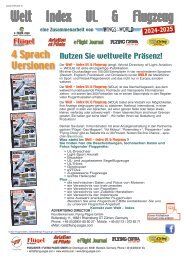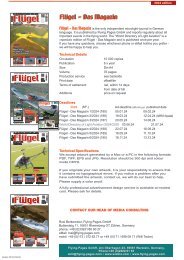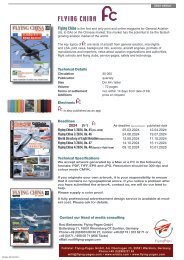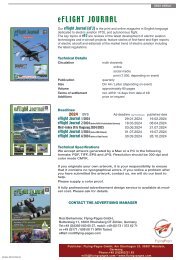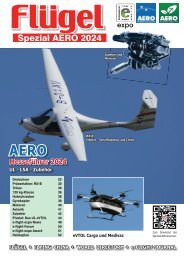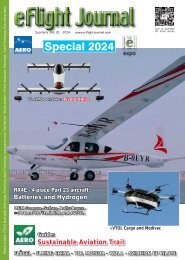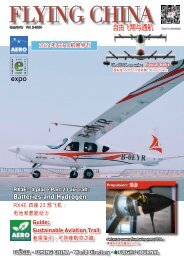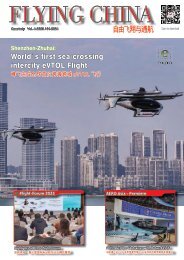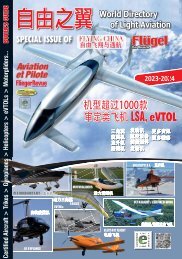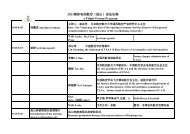Create successful ePaper yourself
Turn your PDF publications into a flip-book with our unique Google optimized e-Paper software.
e Organizations<br />
management. Current automation relies on cross checking<br />
and validation which defaults to a manual mode in the event<br />
of anything out of the ordinary.<br />
There is growing interest in more robust levels of automation<br />
which continue to operate across more portions of the<br />
<strong>flight</strong> envelope (including takeoff and landing) and automation<br />
systems that will continue to operate even during certain<br />
failure or out of the ordinary conditions. At the farther end of<br />
increased automation, there is a significant level of interest<br />
among a number of manufacturers in the “on-demand mobility”<br />
space. Conceptually, aircraft (both conventional takeoff<br />
and landing and vertical takeoff and landing) can become<br />
more integrated into day to day life as the reliability and simplified<br />
operation of increased automation takes hold. While<br />
technologically, these are steps forward, beginning to take<br />
operational credit for these technologies (less training burden<br />
on pilots and <strong>flight</strong> crews, simplified ratings and licensing,<br />
etc.) will require a bit of a leap.<br />
In the coming year, the GAMA Electric Propulsion Innovation<br />
Committee (EPIC) will take on the task of identifying and addressing<br />
areas where increased automation will likely contribute<br />
to the safety and utility of aviation to assure pilots and<br />
<strong>flight</strong> crew training and licensing can be appropriately adjusted<br />
and simplified.<br />
Increased Electrification<br />
In the larger segments of aviation (commercial airlines and<br />
business jets) the strong desire for longer distances and<br />
more efficient operations has pushed many of the traditionally<br />
mechanical or pneumatic systems to become electrified<br />
(electric environmental systems, electric anti-ice, electric actuation,<br />
etc.). As experience is gained with these systems<br />
and as battery energy densities continue to grow, this trend<br />
for increased electrification is speeding up. In most aviation<br />
design circles, concepts for hybrid and electric propulsion<br />
are the next obvious step forward and there is much activity<br />
in this space. In the lighter segments of general aviation,<br />
there are already all electric aircraft flying with second generation<br />
designs following immediately after.<br />
The pressures moving the industry towards increased electrification<br />
(range, efficiency, reliability, etc.) are certain to increase<br />
and the benefits of this direction will continue to grow.<br />
Reliable data indicates that Lithium Ion battery energy density<br />
has increased by 3% for each of the last 10-years and<br />
this trend is expected to accelerate or continue into the foreseeable<br />
future. While approaching the energy density of liquid<br />
fuel is still many decades out, the efficiencies and design<br />
characteristics of electric propulsion already make sense for<br />
lighter aircraft today.<br />
These are truly the exciting early days of hybrid and electric<br />
propulsion and increased automation in aviation. The new<br />
degrees of freedom enabled by these technologies and the<br />
more nimble and responsive design certification environment<br />
have invigorated what was once a sleepy aviation community<br />
into an exciting incubator for growing the not too distant<br />
future of aviation.<br />
Greg Bowles<br />
GAMA’s Vice President for Global Innovation & Policy,<br />
Manager of GAMA Electric Propulsion and Innovation<br />
Committee (EPIC)<br />
For more information on<br />
GAMA and EPIC, contact<br />
Greg Bowles at gbowles@gama.aero<br />
or +32 (2)0 550 39 00<br />
Greg Bowles, Vice President GAMA and<br />
Manager of EPIC presenting at the Dallas<br />
UBER Elevate conference in April <strong>2017</strong>.<br />
e Flight Journal<br />
32



